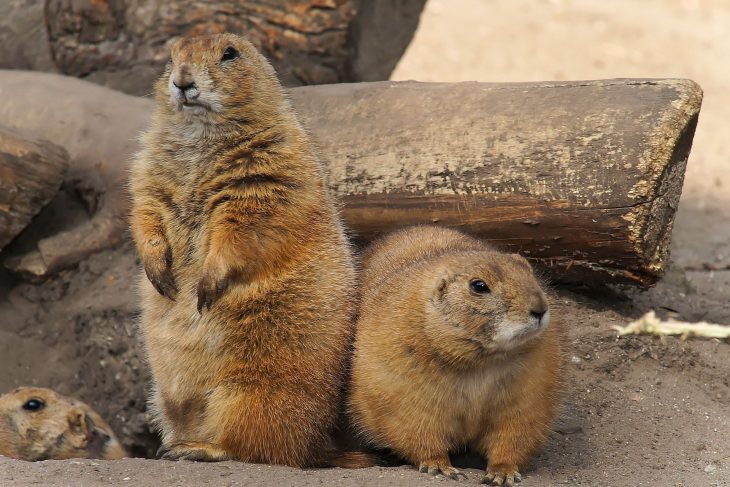
When you hear the word prairie dog, you probably wouldn’t think of a rodent. However, prairie dogs look more like your average rat than an actual dog. Named for their unique calls that sound like a dog’s barking, these animals display a unique set of social behavior that makes them stand out. Aside from having a sophisticated form of communication, these prairie-dwelling creatures have so much more interesting traits. Know more about these cute and curious animals by digging into these interesting fun facts.
- Prairie dogs mainly live in areas with elevations of 2,000 to 10,000 ft (610 – 3048 m) above sea level.
- Prairie dogs can live up to 10 years in captivity.
- Prairie dogs grow from 12 to 16 inches (30 – 40 cm) long from their heads to their tails.
- They typically weigh around 1 to 3 lbs (0.5 to 1.5 kg).
- Female prairie dogs can breed at the age of 1 to 2 years.
- Prairie dogs are primarily diurnal rodents.
- They only live in North America.
- Prairie dogs prefer dry habitats and never live in moist areas.
- They are a type of ground squirrel.
- Male prairie dogs are typically larger and heavier than females.
- There are five species of prairie dogs: black-tailed, Mexican, Gunnison’s, white-tailed, and Utah prairie dogs.
- Like most placental mammals, they have dichromatic color vision.
- Their gestation period lasts for around a month.
- The journals of the Lewis and Clark Expedition described two species of prairie dogs.
- Meriwether Lewis described the black-tailed prairie dog as a “barking squirrel”.
- Despite having the word “dog” in their name, they are not closely related to dogs and other canines.
- Its genus name Cynomys comes from a Greek word that translates to “dog mouse.”
- The phrase “prairie dogging” refers to people simultaneously looking over cubicle walls in response to a commotion, similar to how prairie dogs would pop their heads out of their burrows to watch for predators.
- An old nickname for prairie dogs is “sod poodle,” which inspired the named of the Texas baseball team Amarillo Sod Poodles.
- Female prairie dogs in estrus lick their own genitals to prevent infections and sexually-transmitted diseases.
Prairie dogs greet each other by kissing and nuzzling.
One of the cutest facts about prairie dogs is that these highly social animals “kiss” and nuzzle each other when they enter new areas. While they don’t have lips to lock, they usually touch their noses and teeth against each other as a greeting. This way, they can identify each other and tell whether they’re from the same family group.
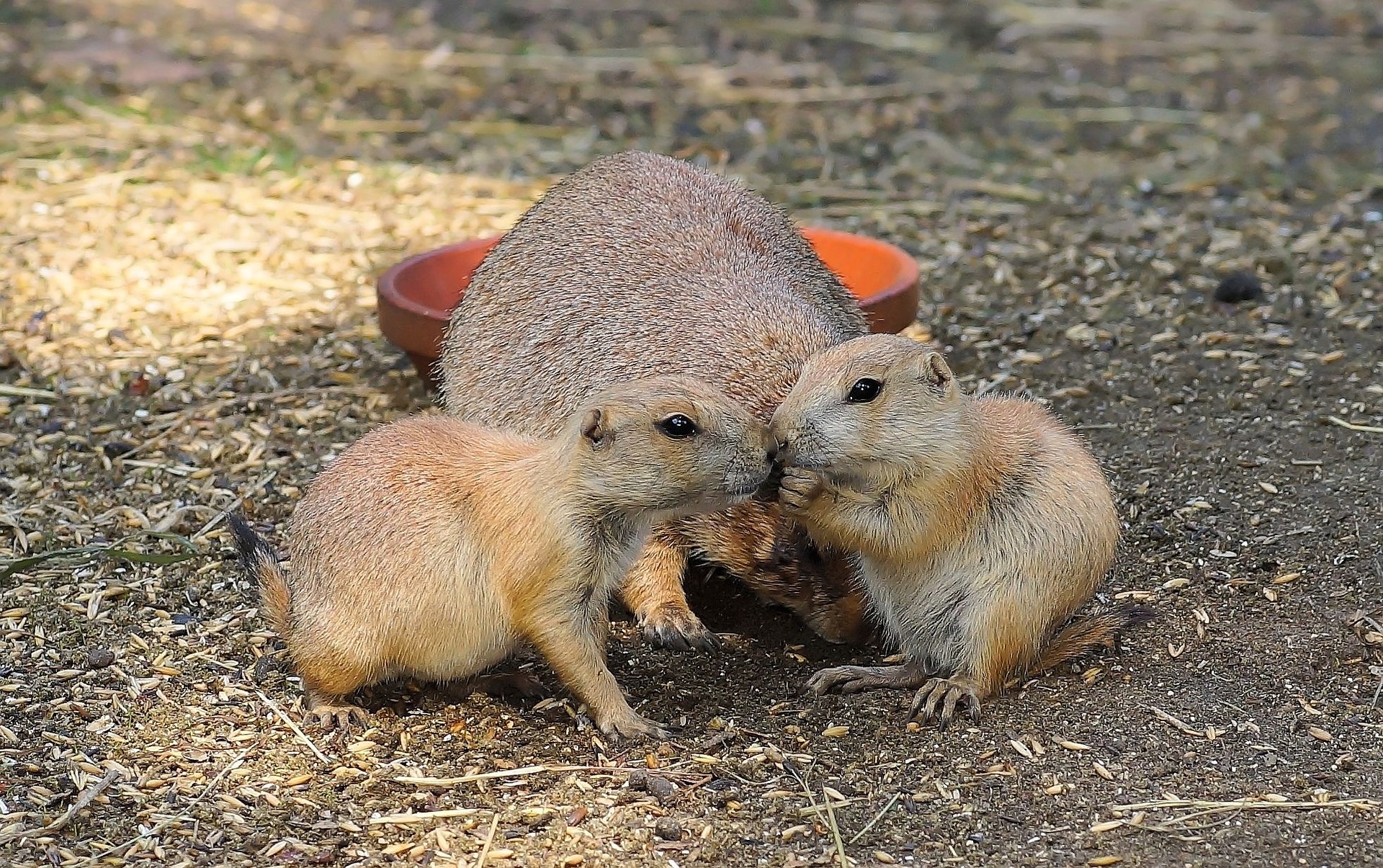
They live in large colonies or towns.
Prairie dogs are social animals that have complex relationships with others of their kind. They live in large colonies which people refer to as a prairie dog village or prairie dog town. These towns occupy a large area of land, housing large numbers of prairie dog families. Most notably, one prairie dog town in Texas reportedly spanned around 25,000 square miles (64,000 km²) with 400,000,000 individual black-tailed prairie dogs (Cynomys ludovicianus).
They have a highly sophisticated language.
One of the most impressive prairie dog facts is that their bark-like calls are part of their unique and sophisticated language. After humans, prairie dogs have one of the most complex forms of vocal communication in the animal kingdom. When it comes to vocal complexity, they even surpass some of the most intelligent animals such as dolphins and chimpanzees. Not only do prairie dogs have a general call for danger, but they can also describe important details about the potential threats.
Through their unique calls, prairie dogs can make different sentences describing the size, color, speed, and type of predator — even with a single chirp! For example, through their calls, they can describe a short man wearing yellow or a coyote that’s fast approaching. These vocal rodents even have specific barks for warning others about a man wielding a gun. Moreover, they can also describe things that are not their natural predators.
Prairie dog families are either called coteries or clans.
Similar to how many different human families make up a human town, the typical prairie dog town has around 15–26 prairie dog families. Depending on the species, the families could either be coteries or clans.
Mexican and black-tailed prairie dog families are called coteries, which are more tightly-knit than the clans of Utah, Gunnison’s, and white-tailed prairie dogs. These family groups live in separate wards within the town.
Prairie dogs are polygamous.
Typically, prairie dogs exhibit harems in which one dominant male mates with a group of females. In a coterie or clan, there may be one or two dominant males, one or two juvenile males, and multiple adult and juvenile females.
Sometimes, females will also mate with other males to increase their reproductive success. Mating most often occurs inside the burrows, where there is less competition with other prairie dogs and there’s a smaller risk of predation.
Female prairie dogs stick with their sisters for life.
Within the families of prairie dogs, the females are typically related to one another and were born in the same group. They stay with this group for life, while the males born in the group wander off into other groups to avoid mating with their kin.
They sometimes mistakenly take care of babies not their own.
Female prairie dogs take care of their young by nursing them, collecting grass for their burrows, and protecting them against threats. On occasion, these motherly instincts make them take care of young prairie dogs that aren’t theirs.
Some researchers suggest that this could indicate a form of communal nursing in their kind. However, other experts contend that they merely raise the pups after mistaking them for their own young.
The leading cause of death for baby prairie dogs is infanticide.
Contrary to their caring nature, the leading cause of death of around 51% of prairie dog babies is actually infanticide. Usually, males that take control over a family group will kill the offspring of the former dominant male. Females also tend to kill off the offspring of their close family members. Experts suggest that they do this to increase the survivability of their own offspring.
Prairie dogs clear the plants around their burrows to better see approaching predators.
When prairie dogs establish a town, they change their local landscape to better suit their territories. To do so, they clear the plants around their burrows so they can better watch out for their long list of predators. Because of their unique landscaping abilities, some scientists even refer to prairie dogs as “ecosystem engineers.”
Their burrows have rooms designated for specific purposes.
Prairie dogs live in burrows underground, which provides them with much-needed protection from various predators and environmental conditions. As great architects, these rodents build their burrows with chambers or rooms that serve specific purposes.
Some rooms serve as stations for nursing the young, some act as their sleeping chambers at night, while others provide shelter during the winter. Normally, the nursing chambers lie deeper underground than the sleeping chambers. Interestingly, they may even have chambers that serve as toilets!
Prairie dogs build listening posts in their burrows.
To better keep tabs on approaching predators, prairie dogs build listening posts in their burrows. These listening posts allow them to safely listen to footsteps without the risk of being seen out in the open.
Other animals also live in prairie dog burrows.
Prairie dogs aren’t the only ones that benefit from their complex burrows – some other animals also take refuge in these spaces. Burrowing owls, mountain plovers, snakes, and other species of ground squirrels also depend on prairie dog burrows for their shelter.
Their burrows have good ventilation.
Another interesting fact about prairie dogs is that they fashion their burrows in such a way that it gets good ventilation. Research on their burrowing habits revealed that when winds blow parallel to the ground, their underground burrows also get proper airflow. This allows the prairie dogs to get proper amounts of oxygen even deep below the ground.
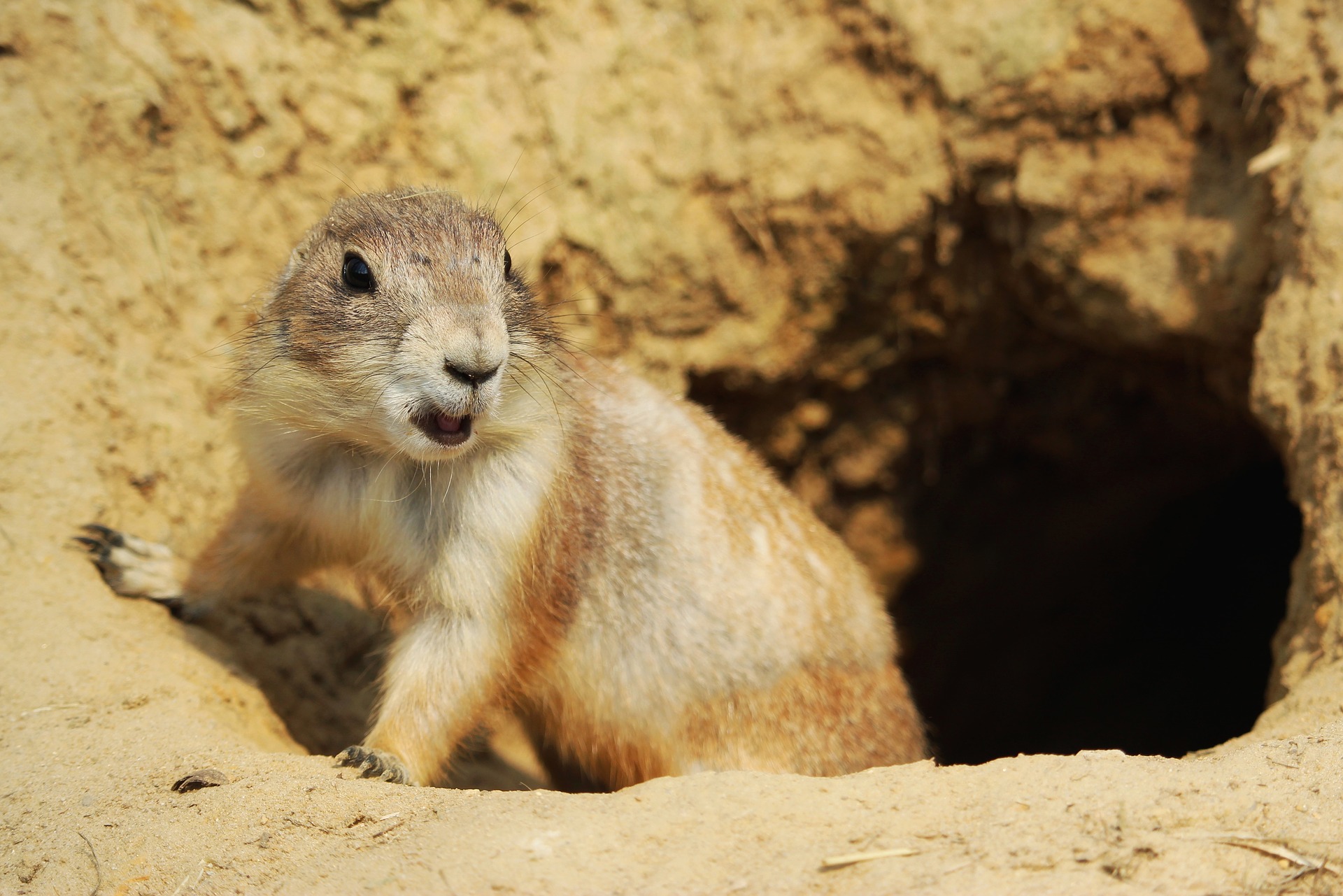
Black-footed ferrets heavily rely on prairie dogs as food.
The endangered black-footed ferrets (Mustela nigripes) rely almost solely on prairie dogs as their source of food. This gave black-footed ferrets the nickname, “prairie dog hunter.” On average, prairie dogs make up around 91% of the black-footed ferret diet.
From the 1800s to the 1900s, populations of prairie dogs declined drastically due to human pest control. When their numbers dwindled, black-footed ferrets almost went extinct. Now, both black-footed ferrets and prairie dogs are protected animals.
Some people keep prairie dogs as exotic pets.
With their adorable, fluffy appearances and their rabbit-like sizes, prairie dogs earned themselves a place in the exotic pet trade. As pets, prairie dogs have a highly specific diet consisting of hay and grasses. They can get aggressive around their breeding seasons. During other times, prairie dogs can be quite sociable companions that can treat humans as parts of their family. Interestingly, they may also be leash-trained.
They take dust baths to rid themselves of parasites.
Similar to chinchillas, which are also rodents that live in arid habitats, prairie dogs do not bathe in the water. Instead, they take dust baths wherein they roll their bodies on dust for about 5 minutes at a time. This way, they get rid of fleas and other parasites from their skin and fur.
Prairie dogs only mate once a year.
Unlike other rodents such as rats and mice that breed and give birth more than once a year, prairie dogs only have a single and short breeding season in a year. For black-tailed prairie dogs, the breeding season occurs after they hibernate — between March and April. Also contributing to their slow reproduction rate is that not all mated prairie dogs give birth. This may be due to failure to conceive or even miscarriages.
They can give birth to up to eight pups at a time.
Once a year, prairie dogs can give birth to a litter with an average of two to three pups. However, the litter sizes can be as few as one pup and as many as eight pups. These babies are born blind and helpless, relying solely on their mothers to survive. Their eyes begin to open at about 5 weeks of age.
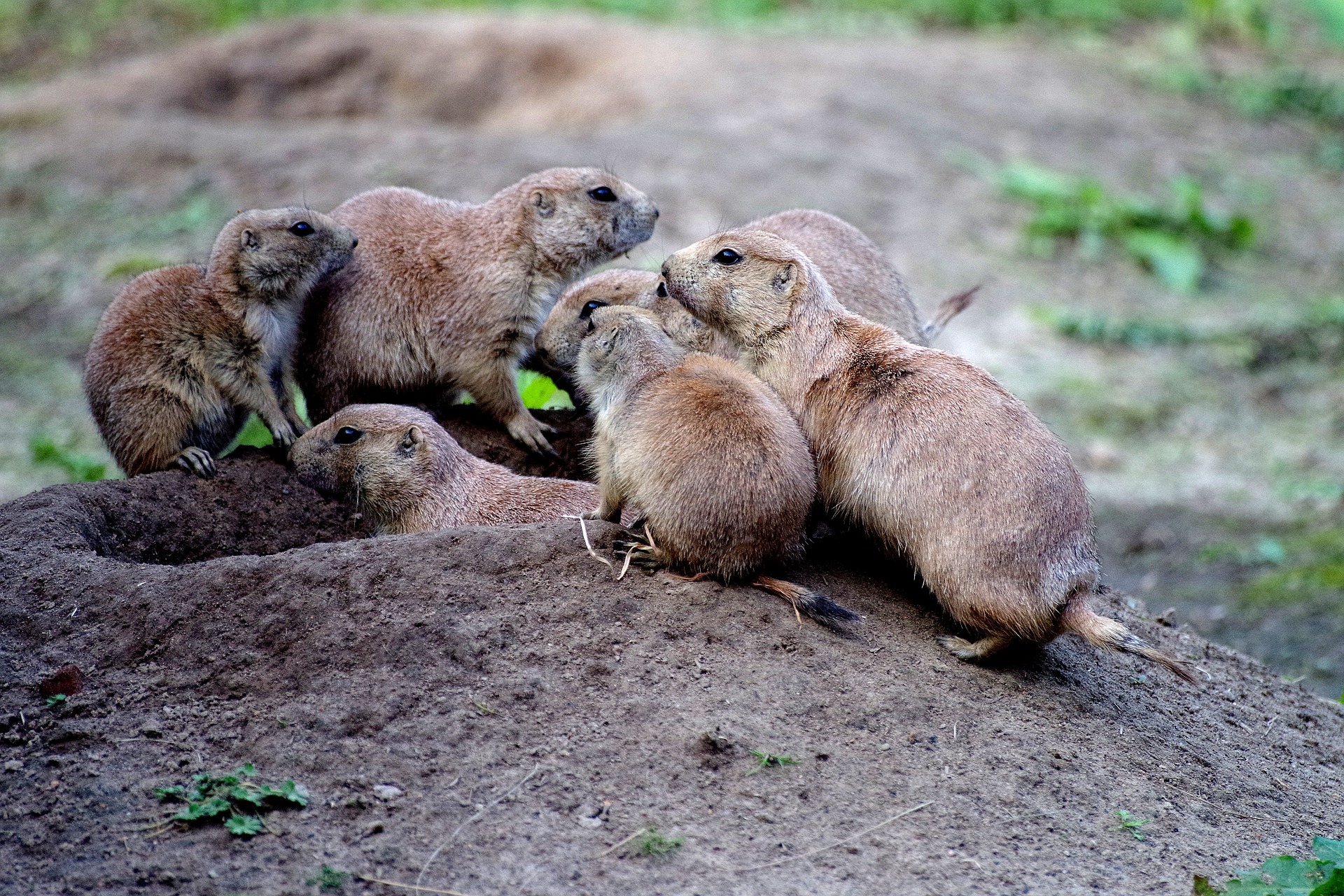
After mating, male prairie dogs prevent other males from mating with female prairie dogs.
Though they mate with multiple females, male prairie dogs can get quite jealous and possessive when it comes to their mates. After they mate with females, male prairie dogs insert a mating plug or copulatory plug inside the female’s vaginas to prevent other males from mating with them. However, females often remove these mating plugs.
They are highly sensitive to sound.
Because these highly social rodents largely communicate through vocalizations, they’re highly sensitive to sound. They evolved with an acute sense of hearing that lets them hear potential predators from underground. Prairie dogs have great sensitivity to low-frequency sounds as low as 4 Hz.
They get water just from eating plants.
As primarily herbivorous animals the prairie dog diet mostly consists of grass, roots, cacti, and thistles in the wild. They live in very arid environments with little rainfall, and therefore mostly get hydration from the plants they eat. On some occasions, they may also eat insects, worms, and even the dung of American bison.
Prairie dogs are a keystone species.
Like bats, prairie dogs serve as a keystone species. Because of their profound influence on their local landscapes and wildlife, the disappearance of prairie dogs would spell bad news for the local ecosystem. Without them, the ecosystem will fall out of balance and lead to the deaths of numerous plants and animals that benefit from prairie dogs.
Hundreds of species depend on prairie dogs. Prairie dogs are important for improving soil quality and returning nitrogen to the soil with their dung. This leads to more nutritious vegetation growing in prairies, which many animals benefit from. Prairie dogs are also an important food source for a long list of predators such as weasels, bobcats, eagles, hawks, and black-footed ferrets.
The Gunnison’s prairie dog is the only prairie dog species with 40 chromosomes.
Gunnison’s prairie dog (Cynomys gunnisoni) primarily lives in the region bordered by southeastern Utah, southwestern Colorado, northeastern Arizona, and northwestern New Mexico. Among the five prairie dog species, only the Gunnison’s prairie dog has 40 chromosomes, more than the 35 chromosomes of the other species. This species also has eyes that are set more to the sides of their heads, giving them good peripheral vision.
Black-tailed prairie dogs do not hibernate.
Black-tailed prairie dogs don’t hibernate in the winter, unlike most species of prairie dogs. Instead, they exhibit torpor, which is an instinctual behavior similar to hibernation that only occurs for short periods of time. During torpor, their heart rate, respiration, and digestion drop significantly. This instinct conserves their energy until the environmental conditions permit them to go out and forage again.
They defend their territories against other prairie dogs.
Prairie dogs invest a lot of energy in building their homes. It’s no surprise that they will defend it fiercely from intruding prairie dogs outside of their groups. Males will fight with other males to defend their territories through ramming, biting, and kicking each other. Sometimes, even females will participate in these fights.
They kill ground squirrels to eliminate competition.
Although prairie dogs are social animals, they’re not friendly towards competition. Prairie dog territories can sometimes overlap with the territories of other species of ground squirrels. Prairie dogs kill the ground squirrels to eliminate their competition. Because they’re herbivores and will not eat the bodies of these ground squirrels, they leave them outside for the birds of prey.
Prairie dogs are susceptible to the plague.
One of the most interesting prairie dog facts is that they’re susceptible to plagues. They potentially carry fleas that serve as vectors to the bubonic and sylvatic plagues, which can be transmitted to pets and humans. As a result, plagues contribute significantly to the loss of prairie dog population.
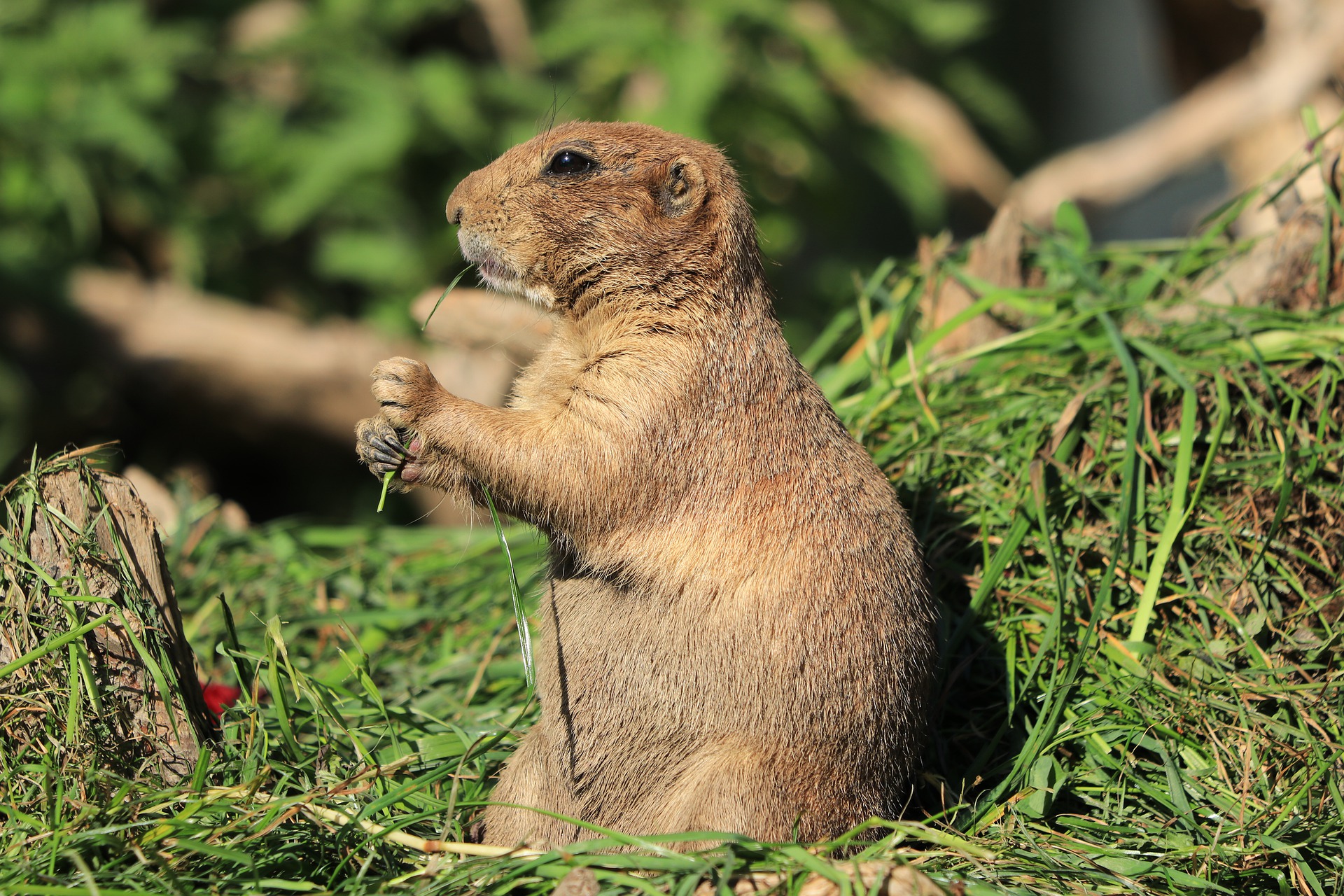
Many farmers don’t like them because of their destructive tendencies.
When prairie dogs make their burrows and establish new territories, they sometimes destroy crops and agricultural land along the way. Because of this, farmers and other land-owners view them as a nuisance and actively hunt or get rid of them through poisons and other methods.
Some prairie dog species are endangered.
With the increase of urban areas, roads, and agricultural lands, the range of prairie dogs are decreasing. Further leading to their decline are factors such as the spread of plagues and unregulated prairie dog hunting and population control. Because of such drastic declines, some species of prairie dogs such as the Mexican and Utah prairie dogs are now endangered.
The CDC lifted the ban on their trade and hunting in 2008.
In 2003, because of threats of spreading plagues and other zoonotic diseases, the CDC imposed a ban on the transport, hunting, and trade of prairie dogs. Although the CDC and FDA have lifted the ban on their hunting and trade since 2008, some states still have laws regarding the protection of prairie dogs.
Was this page helpful?
Our commitment to delivering trustworthy and engaging content is at the heart of what we do. Each fact on our site is contributed by real users like you, bringing a wealth of diverse insights and information. To ensure the highest standards of accuracy and reliability, our dedicated editors meticulously review each submission. This process guarantees that the facts we share are not only fascinating but also credible. Trust in our commitment to quality and authenticity as you explore and learn with us.


